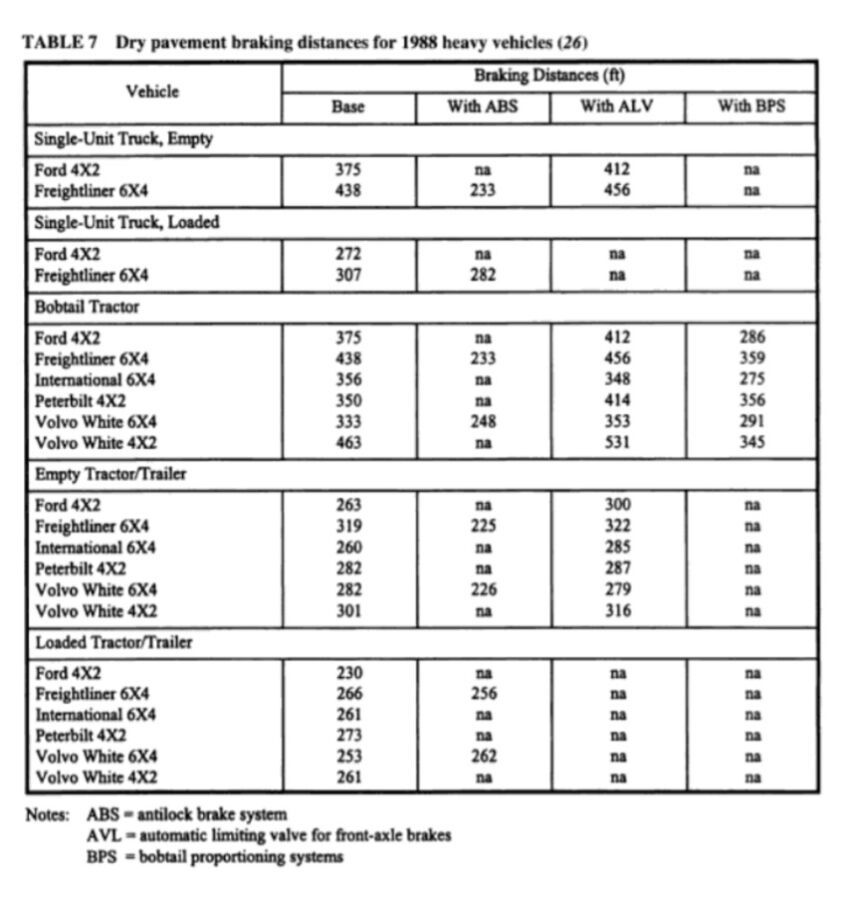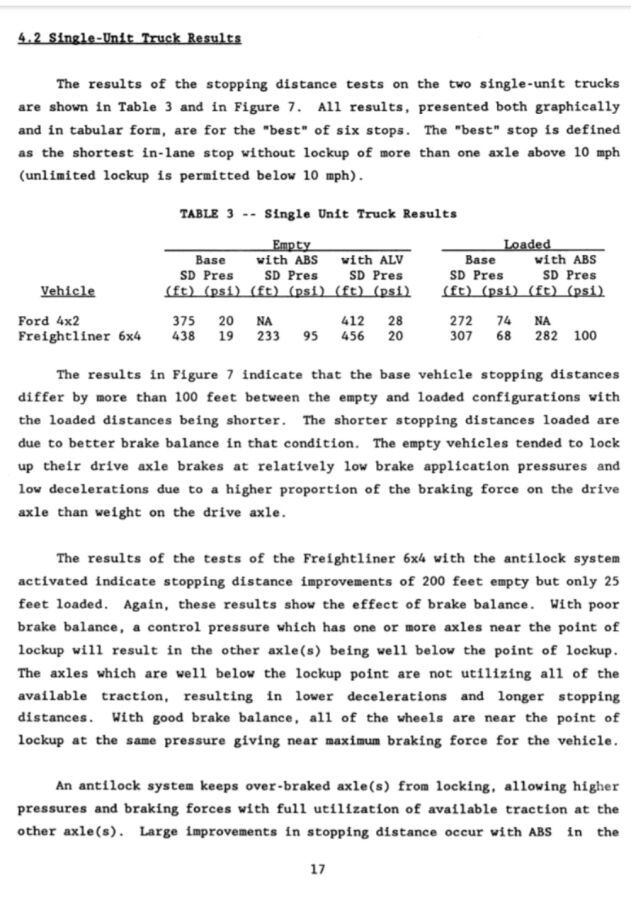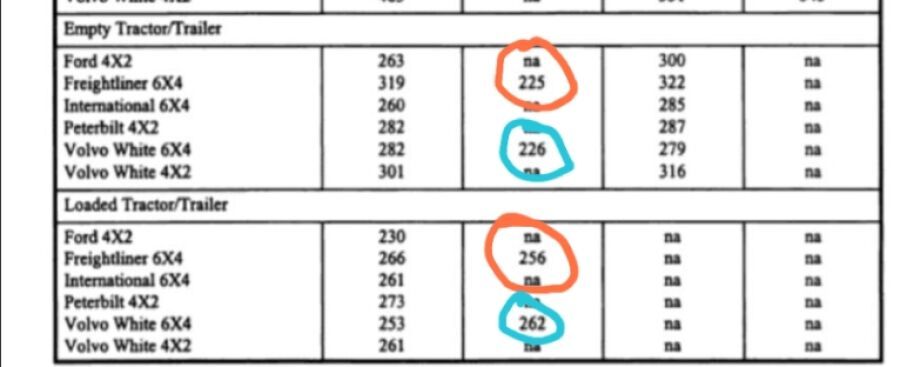The Effect Of Vehicle Weight On Stopping Distance
Topic 30077 | Page 4
I’ll be curious to see the outcome of Errol’s test and prefer a scientific outcome over assumption as many do but I do want to point out a huge flaw in the comparisons some are making on race cars vs passenger vehicles and semi trucks. You can’t even make those comparisons simply because of the factors involved. A race car uses much larger braking surfaces, has a massive contact patch with the road surface in comparison utilizing heat and friction, aerodynamics and downforce as well as special compounds in the tires. If an engineer worked out the math and equipped a large suv identical in every way to the tech involved in a formula 1 or Indy car, the results could be matched. The same would go for a semi but you would see much larger braking surfaces, modified tire compounds to maximize grip etc. The reason a race car decelerates isn’t specifically based on weight alone.
HOS:
Hours Of Service
HOS refers to the logbook hours of service regulations.As Robert Dragon says, you can't compare trains, semis and motor scooters' stopping powers. They have different requirements and systems.
The original question, whether a loaded truck or an empty truck stops quicker is based on the truck, tires, brakes, road, even the driver, and all other conditions save freight weight being same.
Soon I might have to get a pickup load of gravel for my place. If I do, I'll do this experiment with my pickup (Dodge RAM 2500 with a Cummins 5.9 doing the honors).

Here's an actual test of different types of brakes on a couple of class 8 tractors in two configurations. They are tested at Light Load Vehicle Weight vs Gross Vehicle Weight Rating. LLVW was tested bobtail and GVWR was tested using an unbraked trailer.
The LLVW stopping distances were all considerably shorter than the GVWR (check page 8 for LLVW stopping distances and page 11 for GVWR stopping distances).
The peterbilt took 38% longer to stop at GVWR and the Volvo took 25% longer to stop when tested with s-cam drum brakes than at LLVW.
Maybe the handbook was written before ABS was prevalent?
Bobtail:
"Bobtailing" means you are driving a tractor without a trailer attached.
GVWR:
Gross Vehicle Weight Rating
GVWR is the maximum operating weight of a vehicle as specified by the manufacturer, minus any trailers.

Https://www.nhtsa.gov/document/class-8-truck-tractor-braking-performance-improvement-study-report-1-straight-line-stopping
For some reason hyperlink above isn't working for me so that's the address of the study. Sorry I'm not good with computers, that's why I drive a truck!
Matt reports on the DOT/NHTSA test:
They are tested at Light Load Vehicle Weight vs Gross Vehicle Weight Rating. LLVW was tested bobtail and GVWR was tested using an unbraked trailer.
This is true. The study was about different truck braking systems (conclusion: disk brakes on steer and drive axles are way better than S-cam or any mix of them.) This did include the "loaded" and "unloaded" braking on two different power units (Pete and Volvo). The unloaded test was bobtail, and the "loaded" version - adding an unbraked trailer weighing 4,500-lb.
Guess what? the loaded test took longer to stop, both with S-cam and disk brakes!
STOPPING DISTANCES
| Brake System | Unloaded | Loaded |
|---|---|---|
| S-Cam | 221 ft. | 291 ft. |
| Disk | 184 ft. | 232 ft. |
The test trailer was simply added to add weight for the test (only 4,500 lbs - hardly a load for an 18 wheeler), and the trailer braking system was not used.
It looks like the original idea ("Empty trucks require greater stopping distances") may be incorrect.*
*The asterisk: This test was for braking power, not stopping power. That test would need the same truck, trailer and road conditions to compare the loaded stopping distance and unloaded. But I'll shut up now. I still want to run a better real-life test of my own. Any takers?
Note to Matt:
For some reason hyperlink above isn't working for me so that's the address of the study.
The easiest way to enter complicated URL addresses here is to fill the "Link" form address with "www.google.com", and press "Submit". Then in your text box paste your complicated URL in where the www.google.com is:
< a href="www.google.com">Test link
Here: > > > /\ /\ /\
Bobtail:
"Bobtailing" means you are driving a tractor without a trailer attached.
DOT:
Department Of Transportation
A department of the federal executive branch responsible for the national highways and for railroad and airline safety. It also manages Amtrak, the national railroad system, and the Coast Guard.
State and Federal DOT Officers are responsible for commercial vehicle enforcement. "The truck police" you could call them.
GVWR:
Gross Vehicle Weight Rating
GVWR is the maximum operating weight of a vehicle as specified by the manufacturer, minus any trailers.
BMI:
Body mass index (BMI)
BMI is a formula that uses weight and height to estimate body fat. For most people, BMI provides a reasonable estimate of body fat. The BMI's biggest weakness is that it doesn't consider individual factors such as bone or muscle mass. BMI may:
- Underestimate body fat for older adults or other people with low muscle mass
- Overestimate body fat for people who are very muscular and physically fit
It's quite common, especially for men, to fall into the "overweight" category if you happen to be stronger than average. If you're pretty strong but in good shape then pay no attention.

"The test trailer was simply added to add weight for the test (only 4,500 lbs - hardly a load for an 18 wheeler), and the trailer braking system was not used."
They were tested at GVWR plus the 4500 lb axle weight of the unbraked trailer. GVWR happened to be 50,000 lbs on both of the tractors in the study.
GVWR:
Gross Vehicle Weight Rating
GVWR is the maximum operating weight of a vehicle as specified by the manufacturer, minus any trailers.
I finally found the original research on this. It's true, research shows that empty trucks take longer to stop. (Look at the bottom two sections of the chart.) ABS shortens stopping distance, but empty trucks still take longer.
NHTSA's Heavy Duty Vehicle Brake Research Program - Report Number 9


The loaded trucks weighed out at close to or actually more than 80,000 pounds.
Maybe I'm not looking at the table right but it looks like empty trailers actually stop shorter with ABS.

I'm putting together a new version of our High Road Training Program and I came across a statement in the CDL manual that I've always questioned. Here is the exact quote from the CDL manual:
The Effect of Vehicle Weight on Stopping Distance. The heavier the vehicle, the more work the brakes must do to stop it and the more heat they absorb. The brakes, tires, springs and shock absorbers on heavy vehicles are designed to work best when the vehicle is fully loaded. Empty trucks require greater stopping distances because an empty vehicle has less traction.
The extra weight on snow-covered or icy roads can certainly help you maintain a grip on the road surface, potentially allowing a heavier truck to stop faster than a lighter truck.
But what about on dry roads?
I don't know about you guys, but a heavily loaded truck on dry roads did not stop faster than an empty truck. No way.
I've always thought they should revise that statement to specify the difference between dry and slick roads.
What do you guys think?
Doesn't the type of load play a role in how well a truck does (or doesn't) stop? Thinking specifically about tankers loads without baffles.
CDL:
Commercial Driver's License (CDL)
A CDL is required to drive any of the following vehicles:
- Any combination of vehicles with a gross combined weight rating (GCWR) of 26,001 or more pounds, providing the gross vehicle weight rating (GVWR) of the vehicle being towed is in excess of 10,000 pounds.
- Any single vehicle with a GVWR of 26,001 or more pounds, or any such vehicle towing another not in excess of 10,000 pounds.
- Any vehicle, regardless of size, designed to transport 16 or more persons, including the driver.
- Any vehicle required by federal regulations to be placarded while transporting hazardous materials.
Baffle:
A partition or separator within a liquid tank, used to inhibit the flow of fluids within the tank. During acceleration, turning, and braking, a large liquid-filled tank may produce unexpected forces on the vehicle due to the inertia of liquids.OWI:
Operating While Intoxicated
New Reply:
New! Check out our help videos for a better understanding of our forum features

















Preview:
This topic has the following tags:
High Road Training Program Tips For Braking







 TT On Facebook
TT On Facebook
My personal experience says an empty trailer stops sooner. I have locked up the brakes on a fully loaded trailer at 55 mph (construction zone where they had trucks run the left lane closer to the construction, dump truck whipped right out in front of me at 5 mph). I've never locked em on an empty trailer, but I have braked hard enough to make the trailer skip as some folks have pointed out. The empty definitely stopped sooner.
The formulas for braking distance referenced here make mass a wash (essentially they set the kinetic energy formula equal to the work done by braking formula and since both formulas contain mass they wind up cancelling each other out). What they don't account for is that the braking systems in use cannot supply enough force to match static frictional force.
Thus a formula 1 car stops faster than an escalade, which stops faster than a semi, which stops faster than a train.
That said I always want to be heavy in inclement weather.